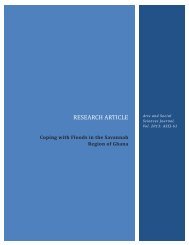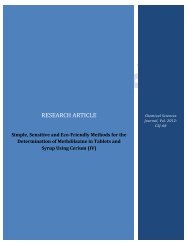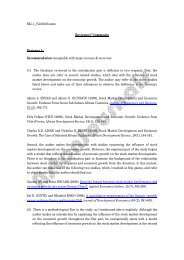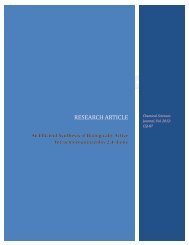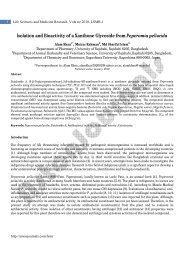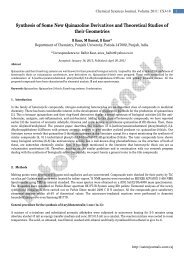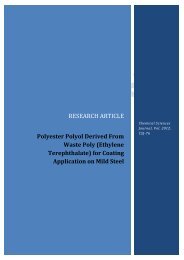Rapid and Sensitive Spectrophotometric ... - AstonJournals
Rapid and Sensitive Spectrophotometric ... - AstonJournals
Rapid and Sensitive Spectrophotometric ... - AstonJournals
Create successful ePaper yourself
Turn your PDF publications into a flip-book with our unique Google optimized e-Paper software.
Absorbance<br />
Absorbance<br />
Absorbance<br />
Chemical Sciences Journal, Vol. 2012: CSJ-80<br />
9<br />
3.1.4 Study of composition of ion-pair complex <strong>and</strong> its conditional stability constant<br />
The composition <strong>and</strong> conditional stability constant of the PPL-BTB or PPL-BCG or PPL-BCP complex formed were<br />
evaluated by applying Job’s method of continuous variations [39] using equimolar concentrations of PPL (prepared<br />
by following the general procedure) <strong>and</strong> the dye. The concentration of dye used in method A <strong>and</strong> B was 5.78 × 10 -5<br />
M, whereas concentration of PPL <strong>and</strong> dye is 1.93 × 10 -4 M in method C. The experiments were performed by mixing<br />
equimolar solutions of drug <strong>and</strong> reagent by maintaining the total volume at 5.0 ml. The plots of the mole ratio<br />
between drug <strong>and</strong> reagent versus the absorbance values were prepared (Figure 5), <strong>and</strong> the results revealed that<br />
the formation of ion -pair complex between drug <strong>and</strong> reagent followed a 1:1 reaction stoichiometry. The<br />
conditional stability constant (K f ) of the ion-association complex was calculated from the continuous variation data<br />
using the following equation [40]:<br />
A/<br />
Am<br />
K<br />
f<br />
<br />
n2<br />
n<br />
1<br />
A/<br />
Am<br />
CM<br />
( n)<br />
where A <strong>and</strong> A m are the observed maximum absorbance <strong>and</strong> the absorbance value when all the drug present is<br />
associated, respectively. C M is the mole concentration of drug at the maximum absorbance <strong>and</strong> n is the<br />
stoichiometry which BTB/ BCG/BCP ion associates with PPL. The log K f values were found to be 7.21, 6.96 <strong>and</strong> 7.32<br />
for BTB method, BCG method, <strong>and</strong> BCP method, respectively.<br />
0.7<br />
0.6<br />
0.5<br />
0.4<br />
0.6<br />
0.5<br />
0.4<br />
0.3<br />
0.3<br />
0.2<br />
0.2<br />
0.1<br />
0.1<br />
0.0<br />
0.0 0.2 0.4 0.6 0.8 1.0<br />
Mole ratio, (V PPL<br />
/V PPL<br />
+V BTB<br />
)<br />
0.0<br />
0.0 0.2 0.4 0.6 0.8 1.0<br />
Mole ratio, (V PPL<br />
/V PPL<br />
+V BCG<br />
)<br />
(a)<br />
(b)<br />
0.8<br />
0.7<br />
0.6<br />
0.5<br />
0.4<br />
0.3<br />
0.2<br />
0.1<br />
0.0<br />
0.0 0.2 0.4 0.6 0.8 1.0<br />
Mole ratio, (V PPL<br />
/V PPL<br />
+V BCP<br />
)<br />
(c)<br />
Figure 5: Job’s plots obtained for (a) 5.78 × 10 -5 M PPL <strong>and</strong> BTB ion-pair complex (b) 1.93 × 10 -4 M PPL <strong>and</strong> BCG ion-pair complex<br />
<strong>and</strong> (c) 5.78 × 10 -5 M PPL <strong>and</strong> BCP ion-pair complex.<br />
http://astonjournals.com/csj



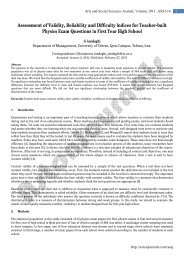
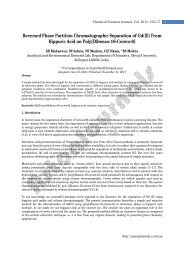
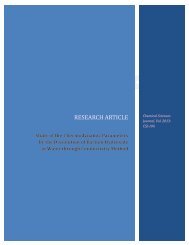
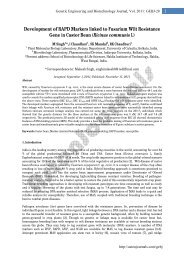

![[1,4]-benzodiazepine-2-one Derivatives as Potent - AstonJournals](https://img.yumpu.com/49117784/1/184x260/14-benzodiazepine-2-one-derivatives-as-potent-astonjournals.jpg?quality=85)
